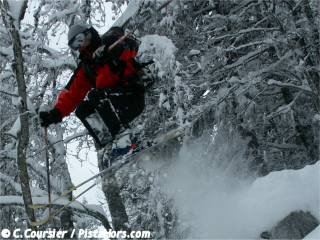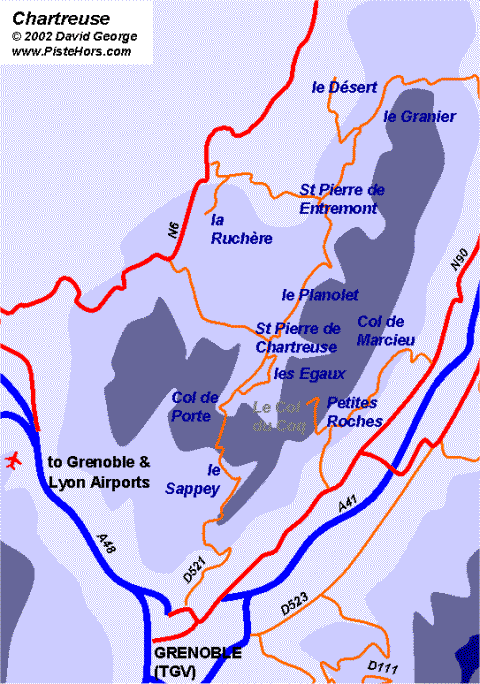
Ski Areas > Northern Alps > Chartreuse Skiing
In 1084 St Bruno and St Hugues crossed over the Col de Porte to a remote spot called Chartrousse where they built a small chapel and some huts to house monks. Their first monastery was destroyed by an avalanche in 1132 a danger still present in the Chartreuse mountains today. The monks were also responsible for the thick green and yellow liquors, ideal for a nightcap on a cold winter evening. To the north of the range things were no safer, in 1248 a thousand meter block of the North Face of Mt Granier broke away. The debris traveled over 5km sweeping away 16 villages and killing an estimated 1,500 people. The slide only stopped when it reached the rising slopes on the other side of the valley. The Savoyard's believed it was punishment for sinners but more recently geologists have shown that the whole range is unstable threatening the Gresivaudan valley. There are now early warning monitoring stations installed throughout the massive.

The Chartreuse mountain range as seen from Chamrouse
The Chartreuse is also intertwined with the history of alpine skiing in France. The mountain range, being situated close to Grenoble, was the ideal spot to build a ski station in those pre-war days before widespread motor transport. In 1934 a Carpenter called Rossat installed France's first drag lift on the fields of the Col de Porte. The Grenoblois would take to their bicycles on Saturday morning to pedal up to the Col with baggage and skis strapped precariously to their backs. They would then enjoy a day's skiing before having a drink at Pierre Garin's hotel by the slopes (M. Garin's son is still mayor and owns the lifts). The Col de Porte is also the site of a snow research centre. Built in 1959 it is a collaboration between the French Weather, Forest and Electricity companies. With a great deal of the regions electricity dependent on hydro-power monitoring snow levels is an important part of predicting generating capacity.

Powder days on the Col du Porte
Today the Chartreuse enjoys the special status of regional park. It is still accessed by the Col du Porte from Grenoble, from the Granier to the North or from St Laurent du Pont from the West. The ten principle summits all stop at around 2000 meters altitude, as if cut short by a giant plane. The snow fall can be deep but is quite variable. In 2002 there was over 50cm of snow in May! A bonus for the ski tourers who made one last climb of the classic 2082 m Chamechaude.
We highly reccommend the Toponeige guidebook: Aravis-Bauges-Chartreuse (toponeige ABC, 2° édition décembre 2005 ; ISBN : 2-912063-10-8). The book is available from Amazon, France if you already have an Amazon account.
The mountains are composed of porous limestone, excellent for cavers. Climbing le Mont Granier on skis (1850m) takes you through a giant cave. However winter travel presents similar risks to glaciated terrain. In January 1997 two snowshoers set off for the plateau d'Arpette below Mont-Granier. Jacky Bech and Denis Roudier, both residents of Lyon, were never seen alive again. An extensive search over 5 days of the 300 potholes by fire crews, police and mountain rescue failed to find any trace of the missing couple. Even flights with a helicopter equipped with an infrared camera were without success. Avalanches are also a risk although the slopes tend to stabilize more quickly due to their low altitude.

<< Chablais | Northern Alps | Faucigny - Grand Massif >>